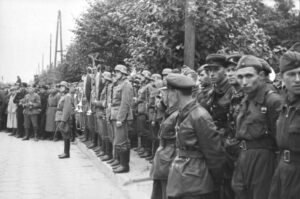 The parade on Unia Lubelska Street in Brest began at 4pm on 22 September 1939 and lasted only about 45 minutes. That was enough time to show the whole world the newly formed alliance between the Soviet Union and Nazi Germany. Soviet and German soldiers paraded in front of the “victory stand”, which had been built for the event and decorated with black swastikas and red stars. Set up in front of the building of the Polesie Provincial Office, it was also a truly theatrical stage from which General Heinz Guderian and Kombrig Semyon Krivoshein jointly welcomed the parade and, with a symbolic handshake, publicly sealed the secret provisions of the so-called Molotov-Ribbentrop Pact, signed a month earlier.
The parade on Unia Lubelska Street in Brest began at 4pm on 22 September 1939 and lasted only about 45 minutes. That was enough time to show the whole world the newly formed alliance between the Soviet Union and Nazi Germany. Soviet and German soldiers paraded in front of the “victory stand”, which had been built for the event and decorated with black swastikas and red stars. Set up in front of the building of the Polesie Provincial Office, it was also a truly theatrical stage from which General Heinz Guderian and Kombrig Semyon Krivoshein jointly welcomed the parade and, with a symbolic handshake, publicly sealed the secret provisions of the so-called Molotov-Ribbentrop Pact, signed a month earlier.
The document defined the spheres of influence of the two occupying powers in Poland. Brest – occupied first by the Germans, according to the terms of the pact – should be handed over to the Soviets. Thus, after a “joyous parade”, the Germans withdrew to the west of the coastline of the Bug, San and Narew rivers. In this way, the Soviets took control of the town and the rest of the eastern areas of the Second Polish Republic. “The ceremonial departure of German troops under the supervision of Soviet representatives” – as some Russian historians euphemistically call “the parade” – officially introduced the German-Soviet division of the occupied territories. Polish historians instead describe it as the Fourth Partition of the country and the beginning of the period of Soviet repressions against Polish citizens in the East.
Photo: Bundesarchiv, Bild 101I-121-0012-15 / CC-BY-SA 3.0, CC BY-SA 3.0 de, https://commons.wikimedia.org/w/index.php?curid=5475937



